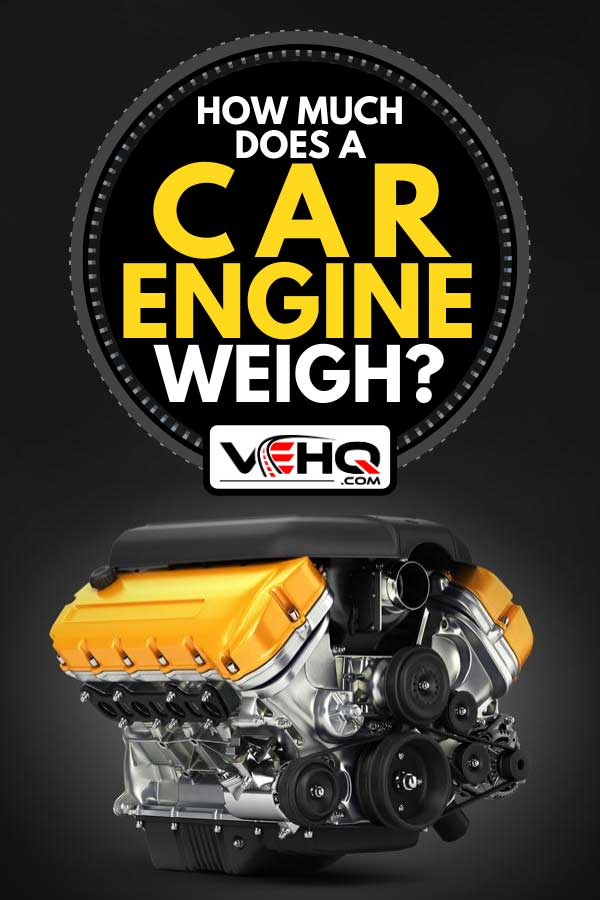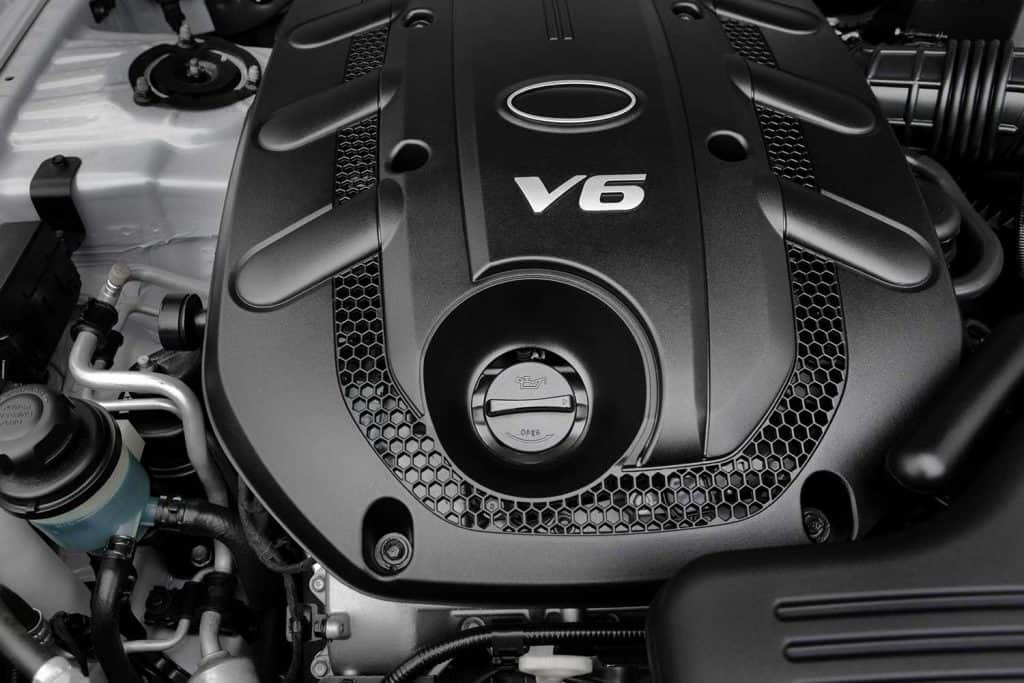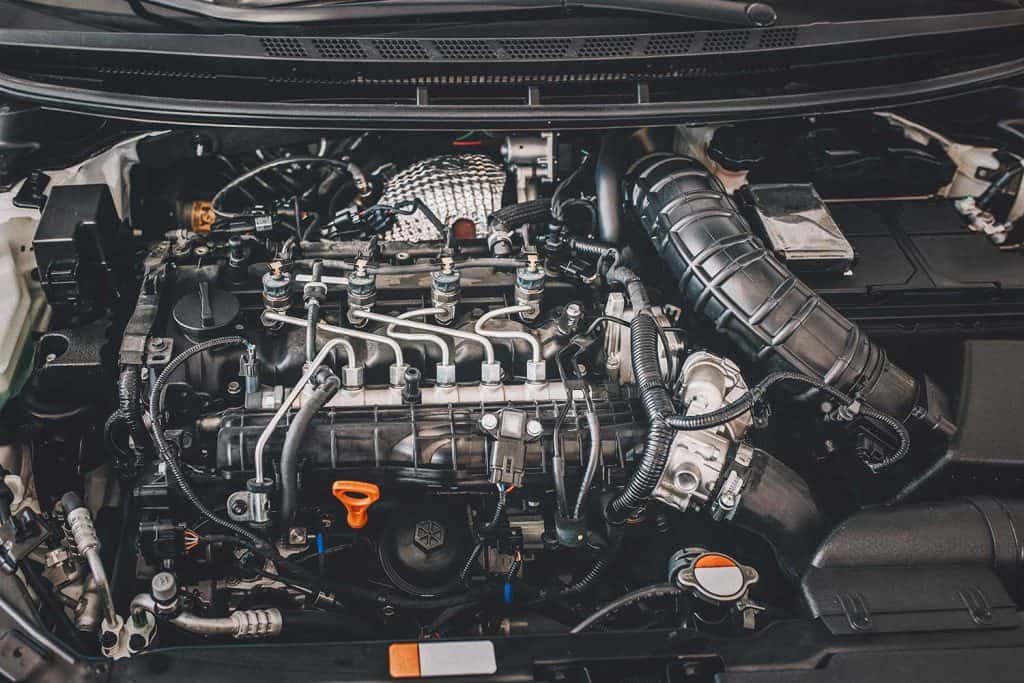Before you go ahead and pull the engine out of your car, it’s best to know how much it weighs first. Or when trying to reduce the overall weight of a vehicle, the engine is a great place to start. How much does a car engine weigh? We researched this to find this information for you.
Engine Size is probably the most significant factor in weight.
- The average V8 engine weighs anywhere from 400-700 lbs.
- The smaller V6 engine usually doesn’t weigh more than 450 lbs.
Fuel type can also add weight to the engine. A gasoline engine is typically between 300-600 lbs. But a diesel engine can weigh over 700lbs.
There are many different reasons why the weight of an engine has such a broad range that can’t easily be summed up in a few sentences. Keep reading for a more in-depth look into what can affect the weight of an engine.

Engine Size and How it Affects weight
The size of an engine can affect its weight range. Engines are often measured by the number of cylinders that they have. Most sedans and family cars have 4 cylinders. With larger vehicles, such as SUVs and pickup trucks, there are often six or eight cylinders and they are arranged along a V-shaped crankshaft. The V shape affords the crankshaft more strength so it can take the beating from additional cylinders.
The weight of additional cylinders, as well as the overall more robust engine design, can certainly add to the engine's overall weight.
How Much Does a V8 Engine Weigh?
The V8 engine can weigh between 400-700lb. The material used to build the engine, engine displacement, and the year an engine was built are a few of the factors that can influence the weight of the engine.
The material chosen to build an engine can significantly influence weight. Cast iron engines are going to be heavier than ones made of aluminum. The Mercedes V8 Single overhead cam (SOHC) cast-iron block weighs 550 lbs., while the Aluminum counterpart is 100 lbs. lighter at 450lbs.
Engine displacement, or the diameter of the cylinders and the stroke of the crankshaft, can make a difference in the weight also. The Buick V8 215 cubic inch small displacement engine weighs 300-350 lbs., while the similarly designed LS1 346 cubic in engine weighs 475 lbs simply because it’s a larger displacement. The larger cylinder holes and the further piston travel of the LS1 increase the external dimensions making the engine heavier.
The year an engine was designed can also change the weight due to advancements in casting technology. The first V8 engine was the Cadillac L head engine, designed in 1914, weighing 595 lbs. After 80 years of technological growth in 1995, Cadillac came out with the North Star V8 weighing between 400-450 lbs.
How Much Does a V6 Engine Weigh?

Since the V6 engine is essentially the same design as the V8 engine only with two fewer cylinders, their weights are affected similarly. A cast-iron engine such as the Buick V6 3.8l, which weighs 375lbs. or the Chevy V6 4.3l, weighing at 425lbs., are significantly heavier than the aluminum V6 engine. An aluminum engine such as the Ferrari Dino V6 weighs 285lbs. At only 225 lbs. the Ford Mondeo V6 engine is nearly half the weight of the cast iron Chevy V6 engine.
Is a Diesel Engine Heavier Than a Gasoline Engine?

In addition to material and design, the fuel used to power the engine can play a role in the weight of an engine. Since a diesel engine creates more power than the gasoline engine, it requires a sturdier build causing it to be heavier. This can be seen in the Oldsmobile 262 cubic in the V6 Diesel engine, which weighs 590lbs.
When looking at an engine like the Chevy Big Block 427 engine, initially weighing 687 lbs., consider the benefit of a gasoline engine. Chevy introduced the L-88 option for the 427 in the late 1960s, which used aluminum head cylinders in place of cast irons, dropping the weight of the engine to about 575 lbs.
The gasoline engine is often lighter because of its ability to use both aluminum and cast iron parts. In contrast, the Diesel engine is more limited in this regard since it has to be made from a denser material like cast iron.
Does a Bigger Engine Last Longer?
The engine size alone does not ultimately affect the longevity of an engine. The application, or type of vehicle and what it is used for, is more critical than sheer size. A larger engine will not have to work as hard as a smaller engine, of course, but the larger engine has heavier components; therefore, it uses more power and fuel. But using a larger engine isn’t always ideal.
Since the engine is heavier, it can wear quicker, so the engine needs to be sized appropriately to the vehicle it is powering. If the motor is too large for the application, it is just wasteful, using an unnecessary amount of power and fuel. While too small an engine will have to work twice as hard to accomplish the same task.
Putting a massive V8 engine into a small car, such as the Honda Accord, is unnecessary when the V6 engine it uses creates more than enough power to get the job done. But when considering a larger vehicle like the Chevy Suburban, a V6 engine would need to work too hard, causing it to wear out faster. So the V8 engine is more practical. The application dictates the ideal engine size. Therefore a larger engine or smaller engine will not alone affect the durability.
Conclusion
So what have we learned about the different weights of engines and how that can affect the overall engine? We now know that the material used in building the engine has the most significant impact on the overall engine weight. That being said, the way the engine itself is designed also has an influence. If it’s a lighter weight you are looking for, it’s probably best to avoid the diesel engine and go with a simple gasoline one instead.
And just because an engine is bigger does not mean that it is necessarily better. There are many more factors that play a role in the longevity of the engine. Now that you have a better understanding of engine weights and their impact, you are ready to take the next step on your car project - and remember to always work with your safety in mind.
